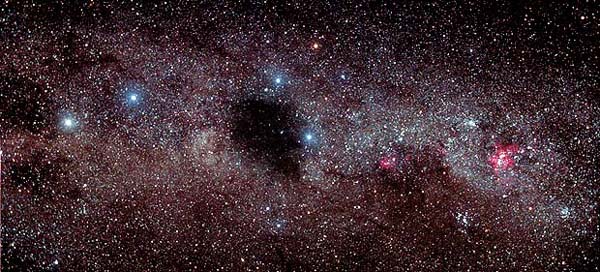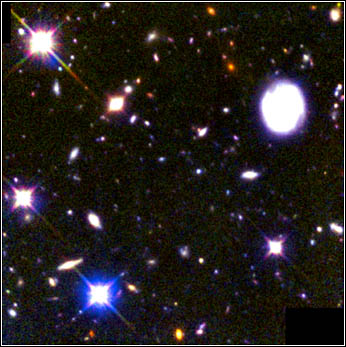To see the Universe in a Grain of Taranaki Sand
To see the Universe in a Grain of Taranaki Sand
[appeared in North and South magazine (New Zealand), May, 1999]
[... and linked to Astronomy Picture of the Day
April 16, 2004,
August 20, 2005,
January 26, 2007,
August 7, 2009.
It had worried me for a long time. I could hear his
voice,
... the total number of stars in the universe is greater than all
the grains of sand on all the beaches of the planet Earth.

 I heard Carl Sagan repeating those words again recently when
I looked along a surf beach on the Taranaki coast. Later that evening I
looked up at the sky. We are fooled somewhat. Our eyes can only resolve
about 5000 of the brightest stars, mostly close to our Sun, and
typically within 1000 light years (1 light year is the distance light,
travelling with a velocity of 300,000 kilometres per second, covers in 1
year).
I heard Carl Sagan repeating those words again recently when
I looked along a surf beach on the Taranaki coast. Later that evening I
looked up at the sky. We are fooled somewhat. Our eyes can only resolve
about 5000 of the brightest stars, mostly close to our Sun, and
typically within 1000 light years (1 light year is the distance light,
travelling with a velocity of 300,000 kilometres per second, covers in 1
year).
 Our Galaxy however, is probably greater than 100,000 light years in
diameter. Hence we can resolve only a very small fraction of our Galaxy
with our eyes. As well, whilst our view of the brightest stars is a
magnificent panorama we do not get any sense of depth or relative
distances of stars. For example, the two bright stars close together,
alpha and beta Centauri, (commonly called The Pointers because they
guide us to the nearby Southern Cross) are at very different distances.
Rigil Kentaurus and Hadar (their common names) are 4.3 and 490 light
years distant, respectively. Hardly neighbours!
Our Galaxy however, is probably greater than 100,000 light years in
diameter. Hence we can resolve only a very small fraction of our Galaxy
with our eyes. As well, whilst our view of the brightest stars is a
magnificent panorama we do not get any sense of depth or relative
distances of stars. For example, the two bright stars close together,
alpha and beta Centauri, (commonly called The Pointers because they
guide us to the nearby Southern Cross) are at very different distances.
Rigil Kentaurus and Hadar (their common names) are 4.3 and 490 light
years distant, respectively. Hardly neighbours!
The faint smudge of light we call the Milky Way, easily visible on a
dark night, is millions of very faint, distant stars lying in the disk
of our Galaxy that our eyes cannot resolve. Dark clouds of dust
(microscopic pieces of carbon and silicon) dimms the light of many more
stars. Apart from a few neighbouring galaxies (including the Large and
Small Magellanic Clouds visible in the southern sky), that appear as
faint, fuzzy blobs of light, our naked eye perception of the universe is
very myopic.
My feet stood on what seemed to be an unfathomable number of sand grains
on that wide, long Taranaki beach. If sand grains were stars, a handful
of sand thrown into an empty sky could easily replicate what we see.
Imagine the brilliant sky you could create with a whole beach of sand!
The voice returned. Carl was probably right. He would have done the
calculation. Doubts remained though, and I knew it was time to put his
voice to rest.
I knew some average numbers for stars and galaxies. In many astronomical
studies an answer to within an order of magnitude (a factor of 10) is
deemed acceptable. Since I had a funny feeling that an average
beach may also be hard to describe, I decided to accept order of
magnitude accuracy.

Our Galaxy, has approximately 400 billion stars. Carl used this number
in the book based on his Cosmos television series and I'll stick with
it. We define a billion as 10 to the power 9, or 1 with 9 zeroes
following it, ie. 1,000,000,000. Big. Is our Galaxy average? Well, it's
a spiral, a little less massive than our magnificent Local
Group neighbour, Messier 31 in Andromeda. As far as spirals go, it's
probably close enough to average. The other galaxies that exist in the
universe, large ellipticals and smaller irregular galaxies, tend to have
more and less stars, respectively. I'll assume that, in terms of star
numbers, our Galaxy represents the average galaxy.
What is the total number of galaxies in the universe? Sagan assumed 100
billion. Is that still valid? Recently the Hubble Space Telescope (HST)
surveyed, to the faintest levels yet detected, a small area of sky.
Extrapolating from the number of galaxies detected by HST to that
expected over the whole sky, I calculate 130 billion galaxies, slightly
larger than Sagans estimate. Then the number of stars in the universe is
400 billion x 130 billion, or about 50,000 billion billion. A billion
billion. That's 1,000,000,000,000,000,000. So, grasp the concept of a
billion billion, then think of 50 thousand of those. Easy!
What are the dimensions of an average, sandy beach on Earth? I was
lucky. I know a Coastal Geomorphologist (doesn't everyone?) who provided
some estimates. Take 360,000 kilometres of coast (the total coastline of
the world is about 1 million kilometres, of which about 36 percent is
sandy), mix with an average beach width of 50 metres (high to low tide
lines), and add a dash of average beach depth of 4 metres.
The diameters of sand grains range from about 0.1 to 2 millimetres.
We'll adopt an average diameter of 0.5 millimetres. Lets stack them
simply, one on top of another (not very likely in a beach I admit), so
that 8000 fit into 1 cubic centimetre. Drum roll please. The total
number of sand grains on our Earth beach is then 600 billion billion.
But wait!, I hear some of you remarking about sand dunes and sand below
the low tide mark. To placate you worriers I'm happy to increase my
initial estimate by a factor of 3. That gives me a grand total of about
2000 billion billion grains of sand on Earth.
The stars win! Carl was right, ... maybe. The excess factor (the number
of stars divided by the number of grains) of 50,000/2000 or 25 is
greater than an order of magnitude, but only just. My individual
assumptions must be wrong at some level. Maybe the average galaxy has
only 40 billion stars (faint surveys do detect many small, ``dwarf''
galaxies). As well, maybe the number of sand grains is three times
greater. (In fact my Coastal Geomorphologist suggested that the average
grain diameter could be smaller than 0.5 millimetres, probably allowing
us to stack a factor of 3 more!). Combine these two changes and the
grains win, just!

Not so fast! Any (conspired) increase in the number of sand grains is
probably offset by the recent discovery of many more galaxies by HST in
the near-infrared region of the electromagnetic spectrum, not previously
detected in optical surveys. Observing in the infrared minimizes the
absorbing effects of dust allowing us to see galaxies enshrouded in
large amounts of dust present because of vigorous star formation. The
odds are that there are many more than 130 billion galaxies in the
universe. I'll cast my final vote in favour of the stars, and I'll admit
a slight astronomical bias (see author notes).
I returned home after three days of travelling. I could now stand on a
beach and not hear Carl Sagans voice. I had even warmed to the number
billion. For example, whilst I was away during those three days, our
Galaxy had moved another 0.2 billion kilometres towards the Virgo
cluster of galaxies (located 650 billion billion kilometres away), and
the population of New Zealand had experienced 1,600 billion heartbeats.
Now, is that resting heartbeat? Here we go again.
Carl Sagan (1934-1996) was Director of the Laboratory for
Planetary Studies and David Duncan Professor of Astronomy and Space
Sciences at Cornell University. Professor Sagan was a leading
popularizer of science and astronomy in particular, and presented the
Cosmos television series and wrote the book (Cosmos, Random House: New
York) based on the series.
Glen Mackie is
Lecturer, in the Centre for Astrophysics and Supercomputing,
Swinburne University of Technology, Melbourne, Australia.
Last text update February 1, 2002

 I heard Carl Sagan repeating those words again recently when
I looked along a surf beach on the Taranaki coast. Later that evening I
looked up at the sky. We are fooled somewhat. Our eyes can only resolve
about 5000 of the brightest stars, mostly close to our Sun, and
typically within 1000 light years (1 light year is the distance light,
travelling with a velocity of 300,000 kilometres per second, covers in 1
year).
I heard Carl Sagan repeating those words again recently when
I looked along a surf beach on the Taranaki coast. Later that evening I
looked up at the sky. We are fooled somewhat. Our eyes can only resolve
about 5000 of the brightest stars, mostly close to our Sun, and
typically within 1000 light years (1 light year is the distance light,
travelling with a velocity of 300,000 kilometres per second, covers in 1
year).
 Our Galaxy however, is probably greater than 100,000 light years in
diameter. Hence we can resolve only a very small fraction of our Galaxy
with our eyes. As well, whilst our view of the brightest stars is a
magnificent panorama we do not get any sense of depth or relative
distances of stars. For example, the two bright stars close together,
alpha and beta Centauri, (commonly called The Pointers because they
guide us to the nearby Southern Cross) are at very different distances.
Rigil Kentaurus and Hadar (their common names) are 4.3 and 490 light
years distant, respectively. Hardly neighbours!
Our Galaxy however, is probably greater than 100,000 light years in
diameter. Hence we can resolve only a very small fraction of our Galaxy
with our eyes. As well, whilst our view of the brightest stars is a
magnificent panorama we do not get any sense of depth or relative
distances of stars. For example, the two bright stars close together,
alpha and beta Centauri, (commonly called The Pointers because they
guide us to the nearby Southern Cross) are at very different distances.
Rigil Kentaurus and Hadar (their common names) are 4.3 and 490 light
years distant, respectively. Hardly neighbours!

